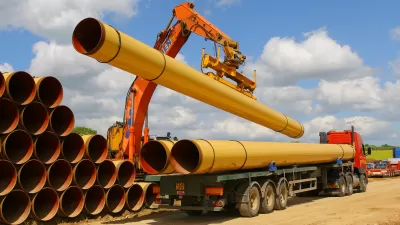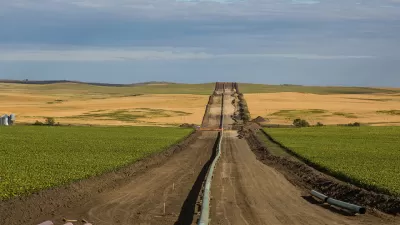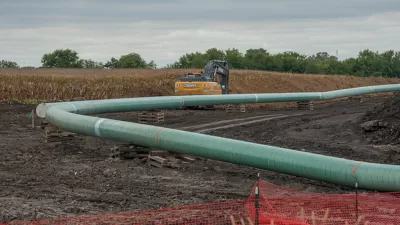Following through on a January executive action, President Trump announced Friday that he was approving the oil pipeline that his predecessor had rejected over a year ago. Oil is already flowing from Steele City, Nebraska to Gulf Coast refineries.

On March 24, President Trump's State Department "signed and issued a Presidential Permit to construct the Keystone XL Pipeline," announced the Calgary-based pipeline builder, TransCanada Corporation. As posted in January upon the president's signing a memorandum giving conditional approval to the Alberta to Nebraska pipeline, the pipeline will carry oil sands crude from Alberta and Bakken oil from North Dakota to the Gulf Coast refineries.
As readers who have followed the nine-year Keystone XL saga (see the Associated Press timeline, which begins in March 2008 with the original Keystone pipeline approval and September 2008 filing by TransCanada for a new Keystone XL route) will recall, former President Obama rejected the trans-national pipeline on Nov. 6, 2015.
Oil has been flowing through the southern, 487-mile leg of the pipeline (Phase III) from Cushing, Okla. to the Port Arthur, Texas region since January 2014. Phase II, from Steele City to Cushing, began operation in 2011. All that was missing was that Presidential Permit to enable a new (hence the "XL") trans-national crossing that required a Republican president to succeed President Obama.
Courtesy of Wikipedia: Keystone Pipeline Route, Phases 1 through 4.
However, the saga doesn't end with Friday's approval. The 1,179-mile Phase IV "shortcut" running from the oil sands of Alberta, Canada, through Montana to Steele City, Nebraska still faces hurdles before it can transport 830,000 barrels a day of oil sands crude from Alberta and Bakken crude from North Dakota, reports Clifford Krauss, The New York Times' national energy business correspondent.
It needs the approval of the Nebraska Public Service Commission and local landowners who are concerned about their water and land rights. Protests are likely since the project has become an important symbol for the environmental movement, with the Canadian oil sands among the most carbon-intensive oil supplies.
Krauss describes the "mixed-blessing" reaction by Prime Minister Justin Trudeau: good for the Canadian economy, but a likely setback for meeting his climate targets. [See related post this month on Trudeau's award from the energy industry.]
What happened to U.S.-manufactured steel for the pipeline?
Remember President Trump's insistence, solidified in a presidential memorandum on Jan. 24, that pipelines that run through the United States be manufactured domestically?
"We are -- and I am -- very insistent that if we're going to build pipelines in the United States, the pipe should be made in the United States," Trump said on Jan. 24. [Cleveland.com]. Krauss writes that "the White House has since suggested that the Keystone project would not be subjected to those rules because it is not a new project."
However, the Sierra Club provides a different explanation for Trump's reversal: "According to reports, TransCanada's threat to continue [it's $15 billion] NAFTA suit contributed to the White House decision to renege on Trump's promise that the pipeline would be made with U.S. steel." An hour after President Trump made his announcement, TransCanada dropped its suit, the Club reports.
Notwithstanding President Trump's announcement in the White House on Friday that "[i]t’s a great day for American jobs and a historic moment for North American and energy independence," don't expect President Trump to appear at any Ohio steel plants announcing new jobs.
FULL STORY: U.S., in Reversal, Issues Permit for Keystone Oil Pipeline

Planetizen Federal Action Tracker
A weekly monitor of how Trump’s orders and actions are impacting planners and planning in America.

Map: Where Senate Republicans Want to Sell Your Public Lands
For public land advocates, the Senate Republicans’ proposal to sell millions of acres of public land in the West is “the biggest fight of their careers.”

Restaurant Patios Were a Pandemic Win — Why Were They so Hard to Keep?
Social distancing requirements and changes in travel patterns prompted cities to pilot new uses for street and sidewalk space. Then it got complicated.

Platform Pilsner: Vancouver Transit Agency Releases... a Beer?
TransLink will receive a portion of every sale of the four-pack.

Toronto Weighs Cheaper Transit, Parking Hikes for Major Events
Special event rates would take effect during large festivals, sports games and concerts to ‘discourage driving, manage congestion and free up space for transit.”

Berlin to Consider Car-Free Zone Larger Than Manhattan
The area bound by the 22-mile Ringbahn would still allow 12 uses of a private automobile per year per person, and several other exemptions.
Urban Design for Planners 1: Software Tools
This six-course series explores essential urban design concepts using open source software and equips planners with the tools they need to participate fully in the urban design process.
Planning for Universal Design
Learn the tools for implementing Universal Design in planning regulations.
Heyer Gruel & Associates PA
JM Goldson LLC
Custer County Colorado
City of Camden Redevelopment Agency
City of Astoria
Transportation Research & Education Center (TREC) at Portland State University
Camden Redevelopment Agency
City of Claremont
Municipality of Princeton (NJ)






























